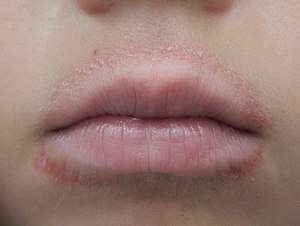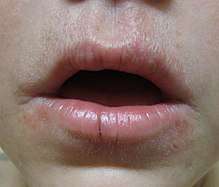Lip licker's dermatitis
Lip licker's dermatitis, also called irritant contact cheilitis, is a type of skin inflammation around the lips due to saliva from repetitive lip licking. The resulting scaling, redness, chapping and crusting make a well-defined ring around the lips. The rash may extend as far as the tongue can reach and frequently spares the angle of the mouth.
| Lip licker's dermatitis | |
|---|---|
| Other names | Irritant contact cheilitis, perioral irritant contact dermatitis, perioral dermatitis |
 | |
| Lip licker's dermatitis from a child repeatedly licking lips | |
| Causes | Repeated lip licking |
| Diagnostic method | Based on symptoms |
| Differential diagnosis | Perioral dermatitis |
| Medication | Emollient |
It is treated with simple moisturisers, emollients, and sometimes topical steroids.[1][2][3] It is different to perioral dermatitis, which spares the vermillion border and is worsened by topical steroids.[4][3] Children are affected more often than adults.
Signs and symptoms

Redness around the lips in circumoral distribution with dryness and scale is typical.[3][5] Chapping may also occur, especially in cold weather.[6]
Causes
Repeated licking resulting in a cycle of wetting and drying causes the redness, fissuring, and scale.[4] It can also occur with lip chewing, thumb sucking, or excessive drooling.[7]
Wind instrument players may also experience lip licker's dermatitis.[8]
Compulsive licking of lips causing lip licker's dermatitis is also seen as psychological disorder.[9]
Persistent and continuous breathing from the mouth can cause dry lips and result in the temptation to repeatedly lick the lips with the aim to keep them moist.[10]
Diagnosis
The diagnosis of lip licker's dermatitis is from the history and inspection of the rash. It is important to distinguish it from allergic contact dermatitis and perioral dermatitis which are characterised by papules in the perioral area and sparing of the vermillion border, and worsened by topical steroids.[11][3]
Treatment
Generous application of bland emollients can improve the rash. However, complete resolution will not occur until the lip licking stops.[4] Breaking the cycle (dryness, then licking, followed by more dryness) is key to treatment. Sometimes, unlike in perioral dermatitis, topical steroids may be used for few days only.[12]
References
- Dyall-Smith, Delwyn. "Eczematous cheilitis | DermNet NZ". dermnetnz.org. Retrieved 4 January 2020.
- "EK02.21 Irritant contact dermatitis due to saliva". icd.who.int. ICD-11 - Mortality and Morbidity Statistics. Retrieved 4 January 2020.
- Paller, Amy S.; Mancini, Anthony J. (2016). "3. Eczematous Eruptions in Childhood". Hurwitz Clinical Pediatric Dermatology: A Textbook of Skin Disorders of Childhood and Adolescence (5th ed.). Edinburgh: Elsevier. pp. 62–63. ISBN 9780323244756.
- Cohen, Bernard C (2013). "9. Oral Cavity". Paediatric Dermatology. Saunders Elsevier. pp. 240–263. ISBN 978-0-7234-3655-3.
- Tolaymat, Leila; Hall, Matthew R. (2019), "Perioral Dermatitis", StatPearls, StatPearls Publishing, PMID 30247843, retrieved 4 January 2020
- Rudikoff, Donald; Cohen, Steven R.; Scheinfeld, Noah (2014). Atopic Dermatitis and Eczematous Disorders. CRC Press. p. 51. ISBN 978--1-84076-195-5.
- Leung, Donald; Szefler, Stanley; Bonilla, Francisca; Akdis, Cezmi A; Sampson, Hugh (2016). "Contact Dermatitis". Paediatric Allergy (third ed.). pp. 467–481. ISBN 978-0-323-29875-9.
- Bolognia, Jean L; Schaffer, Julie V; Cerroni, Lorenzo (2018). "Environmental and Sports-Related Skin Diseases". Dermatology (4th ed.). Elsevier. pp. 1569–1594. ISBN 978-0-7020-6275-9.
- Harth, Wolfgang; Gieler, Uwe; Kusnir, Daniel; Tausk, Francisco A. (2008). "Part II: Specific Pattern of Diseases". Clinical Management in Psychodermatology. Springer. p. 20. ISBN 9783540347187.
- Robert Kliegman (2016). Nelson Textbook of Pediatrics. Elsevier. p. 1078–1082. ISBN 978-0-323-44919-9.
- Vanderweil, Stefan; Levin, Nikki A. (2009). "Periorbital Dermatitis: It's Not Every Rash That Occurs Around the Mouth". Medscape. Retrieved 4 January 2020.
- Braun-Falco, Otto; Plewig, Gerd; Wolff, Helmut Heinrich; Burgdorf, Walter (2000). "12. Dermatitis". Dermatology. Berlin: Springer. p. 510. ISBN 3-540-59452-3.